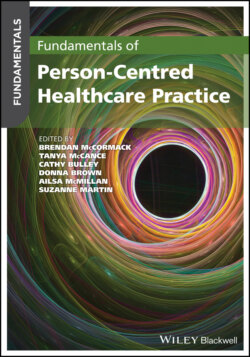Читать книгу Fundamentals of Person-Centred Healthcare Practice - Группа авторов - Страница 72
The journey through ‘knowing self’: tools and approaches
ОглавлениеFinding ways to engage in the process of ‘knowing self’ and improve self‐awareness is important for delivering person‐centred practice. We need to know self to be authentic and to work collaboratively with others (McCormack and McCance 2017). As you read through this section, you are encouraged to reflect on the examples provided and consider their contribution to the process of ‘knowing self’ and the role played by yourself and others during the process. The selection of tools and approaches outlined below is not exhaustive. Further ways of knowing self are outlined later in this chapter (reflection and feedback) and in Chapters 1, 5, 12 and 29. This section also requires you to explore what works best for you. For any of these tools and approaches to be able to help during your journey through ‘knowing self’, they require engagement in critical reflection.
The Johari Window (Luft and Ingham 1955) is a tool normally used within teams or groups (working either one to one or as a group), to help gain more self‐awareness about what we know about ourselves and what others know about us. It is divided into four quadrants (windows) that outline potential forms of awareness, behaviours, motivations and feelings in a relationship. The first window represents the behaviours that are openly seen by ourselves and others. The second refers to behaviours, feelings and motivations that you (self) are unaware of (blind spot) but are open for others to see. This highlights inconsistencies between what we say and what we actually do. These behaviours may benefit from feedback from others in order to shrink the blind spot. Quadrant three is a hidden window in which behaviours, motivations and feelings are known to self but are hidden from others (the private self). Finally, the fourth window is an area of aspects unknown to both ourselves and others. As we grow and develop, these ‘hidden and unknown’ elements of who we are as persons may become known to us – this can be challenging to experience. For more information about this tool see: www.youtube.com/watch?v=KdYo5jn29w4.
Alternatively, journalling is a progressively evolving written record of thoughts, feelings, experiences and learning, designed to increase self‐awareness and self‐understanding of practice. When developing a journal, we need to consider the medium to use (e.g. paper, computer, phone), how much time to dedicate to writing, if the writing will be private or shared and how structured the journal will be (Dimitroff 2018). Journalling offers an opportunity to be creative. If you are interested in knowing more see: www.americannursetoday.com/journaling‐valuable‐registered‐nurses and https://criticalcreativity.org.
Learning sets offer a structured approach for 6–8 people to meet regularly and learn collectively from one another's experiences. The focus of this approach is on learning (about oneself and others) and on professional development. Participants usually work together for an agreed period of time, taking turns at presenting their issue, in allocated time slots. The ‘set’ generally has a facilitator who is part of the group but also has responsibility for creating an encouraging, challenging and focused learning environment. To explore this approach further see: https://rapidbi.com/action‐learning‐sets.
